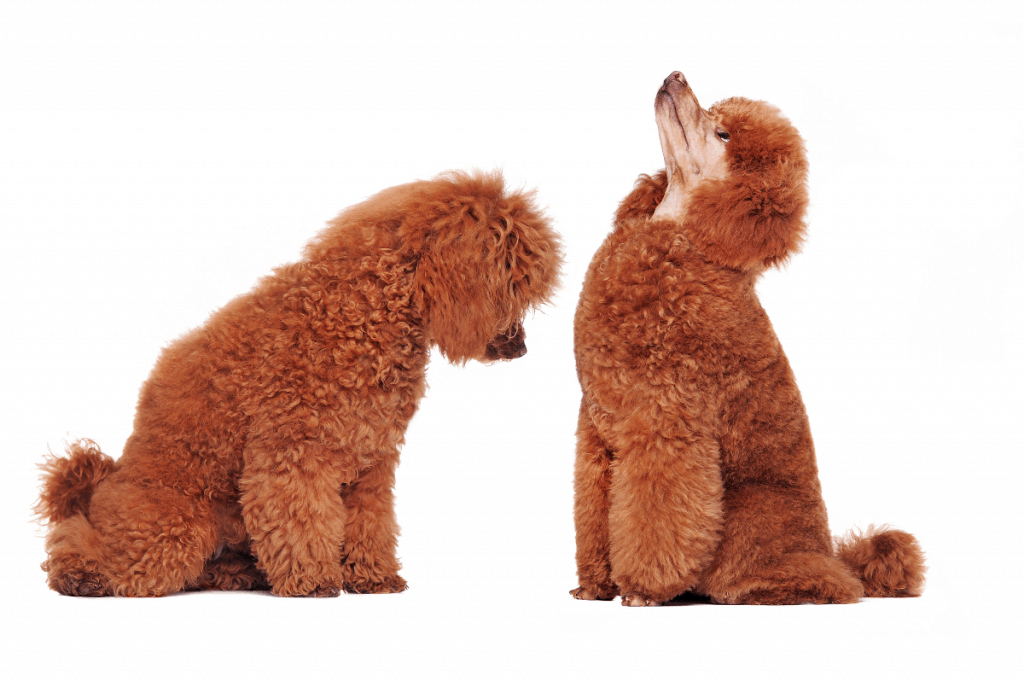If you have heard that red poodles are rare, it’s true. However, if you’ve ever seen one you will never forget. Red poodles are some of the most spectacularly beautiful canines you will ever see.
The path to producing such a shocking and stunning dog was not easy. In this article, we are going to cover everything there is to know about red poodles.
What is a Red Poodle?
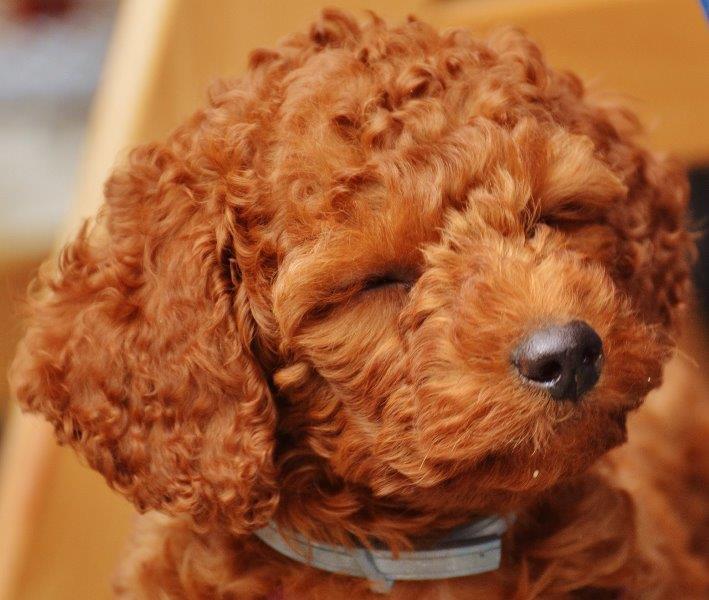
A true red poodle has black points. Liver points are accepted by not preferred, especially in the United States.
Many people do not know that red poodles came from the apricot poodle bloodline. This is usually hard to believe because red poodles have a much darker and richer color than the more faded look of an apricot. It is the goal of many breeders to obtain the deepest, darkest shade of red possible that doesn’t fade.
Red poodles are a new color in the breed. They only officially became recognized by the AKC in 1980. In Canada some breeders joined to form the Apricot Red Poodle Club in order to up hold the high standards set for breeding red poodles.
Let’s be clear, there is still a lot to know and learn about the genetics of red poodles. However, it does appear that red poodles have a separate gene that makes them fundamentally different from apricot poodles.
One thing that breeders have come to understand is that the gene involved in darkening the coat of an apricot poodle does not have an effect on black poodles. In fact, the apricot gene is a recessive gene to all poodle colors except for white.
Where do Red Poodles Come From?
Red poodles have an interesting history. Ilse Konig was the first person to develop a red color. The color was first developed by taking a large male standard poodle and breeding it with an apricot female miniature poodle. Through the years the red poodle was developed more and more through careful, selective breeding
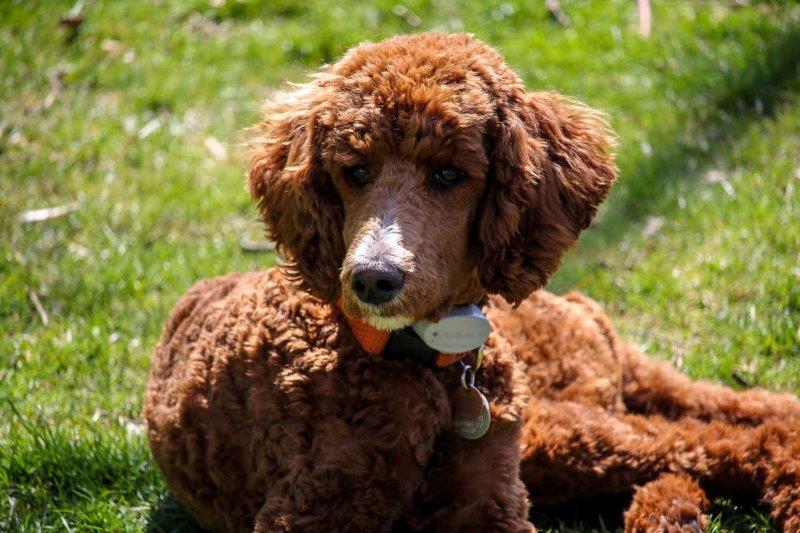
Since breeding poodles of different sizes is quite rare the litters from these pairings were placed into a new category called the Klein or Moyan. These categories are or popular in Europe than anywhere else. Essentially this created a size in between the standard and miniature. Over time, the breeding of the largest dogs from each litter allowed for the standard-sized reds that we see today. As a result, standard-sized reds are now much easier to breed.
Now, as a result, we have red poodles in every poodle size. Some of the earliest of the reds were known to be a bit more feisty and aggressive than those reds we have today. This is in part due to the breeding of standard with a miniature and also due to some breeders only focusing on breeding for color only. There was also a certain amount of inbreeding that occurred among some breeders. These temperament challenges are largely a thing of the past and reputable breeders produce calm loving reds.
As you can see, one of the biggest challenges in developing the red color was to also take into consideration other qualities that make a well-bred poodle. These qualities include health, temperament, beauty, and conformation. Today, it’s much easier to find well-bred reds.
Do Red Poodles Change in Color?
Usually, when red puppies are born, they have a deep, rich red color. Typically, when they are about 6 weeks old their coat will begin to fade a little bit. About 4 Weeks later a sharp red line will be visible next to the skin if you part their hair. This is where the new coat will come in. It can be quite exciting for new red puppy owners to see.
One of the interesting things about red poodles is that their coats can, and will, go through many changes over the course of their life. It is not uncommon or their coats to go from lighter to darker, to lighter and back to a darker shade. Every red poodle has its own unique color of red.
There is really no way to know how their coat will change over time. Some reds retain a dark rich color while others may brighten or lighten over time.
If the pedigree of a red poodle contains lots of diluted color breeding (Especially blue, silver or cafe and also cream and apricot) then there is a high chance that they will fade upon maturity.
Like many other breeds of dogs, red poodles can change color. In fact, it’s common for poodles to lighten in color as they age. It doesn’t mean that there are not exceptions what it is something that is seen most often.
When looking for a breeder take a close look at the poodles they have bred in the past. This will give you a better idea of what to expect. But remember each red poodle is different. Not to worry though, this doesn’t mean that their adult coat will not be stunning.
Standard Red Poodles
Standard Poodles are by far the most common, most well-known, arguably the most sought-after side poodle. One thing that sets the red pool apart from other colors is simply just how rare of a sight it is. Chances are if you step outside today and see a poodle, it won’t be red.
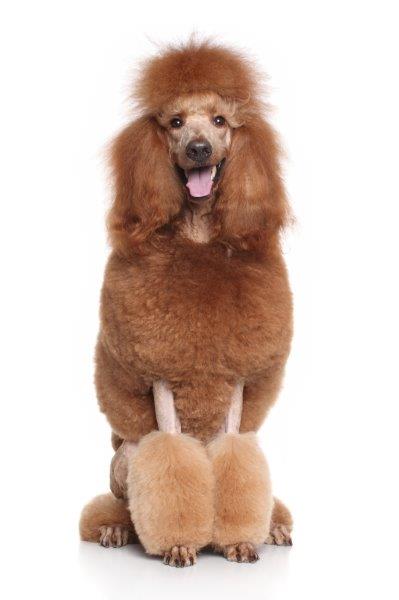
Red standard poodles are among the most majestic, regal, and stunning of the breed. With a happy, light springy gait, what’s not to love?
While they are the largest of the breed they don’t really take up much space in the house as they often like to stretch out or lay at your feet.
They must be 15 inches in height or higher at the withers to be considered a standard. They can weight anywhere between 45 to 75 pounds.
Miniature Red Poodles
Upon first glance, you may think that the red miniature poodle it’s just like standard or toy poodle in appearance. There is actually a slight difference in their appearance. They can take on a slightly more square appearance.
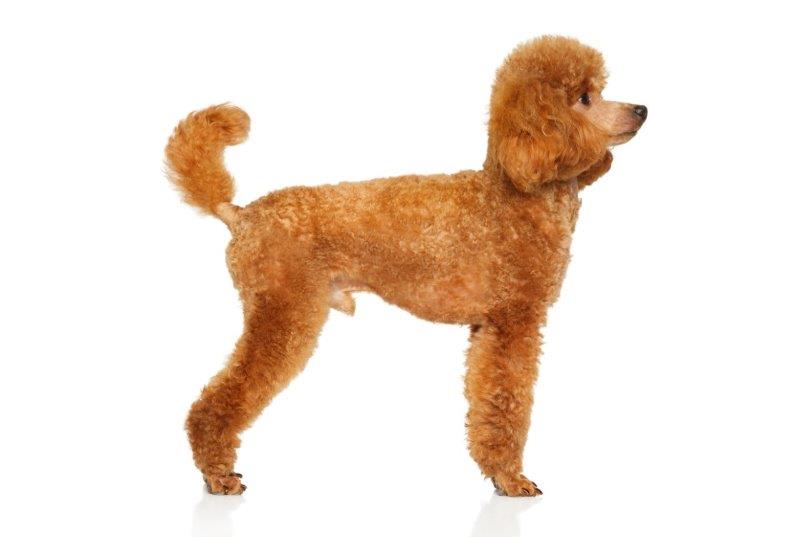
Miniature red poodles are from 10 to 15 in height with an average weight of about 20 pounds. This size poodle takes on more of a square appearance in terms of proportion. When taking into account it’s height and length. These two measurements are usually very close, hence the “square” body.
These dogs super sporty and love outdoor activities. They are fast, agile, and eager to please. Did we mention fun-loving and amusing? Owners should have very little trouble training these dogs as they are extremely intelligent.
For many families, the miniature red poodle is just the right size. Not too big, not too small, with just the right amount of cuteness!
Toy Red Poodles
Red toy poodles are like mini balls of red fur. Like other colored toy poodles, they grow up to 10 inches in height and usually weight between 6-9 pounds.
Between the miniature and standard sized poodles, toy poodles are the smallest of the three. They are among some of the cutest and most adorable toy dogs you can find.
Even though they are small in size they have big personalities and a ton of energy. It’s hard to resist picking one up and cradling them in your arms.

You’ll find that the color of red toy poodles can change over time and with age just like miniatures and standards. They are also available in beautiful, deep, rich reds and lighter cinnamon shades as well.
One thing to consider when getting a red toy poodle is the extra bit of care that comes with taking care of a dog this size. Because of its small size, extra care must be given to keep an eye on any size related healh issues.
Teacup Red Poodles
If you think red poodles are hard to find then let’s be honest, red teacup poodles super hard to find.
But wow when you do find one I must say they are some of the cutest, most adorable, tiny red poodles you have ever seen.

Now to be clear, red teacup poodles are technically toy poodles but much smaller in size. It’s important to know that because all of its reduced size they are very fragile. They can also sometimes be prone to health issues and can require extra care and attention.
You must take great care in finding a reputable breeder to ensure that your pup will be healthy and resilient.
Does the weather affect coat color?
The sun can certainly have a negative impact on your red poodle’s coat. But it really just depends on your poodle. Generally, the sun has a more profound impact on light and white-colored poodles.
if your poodle often plays outside in the bright sunlight it’s possible that you may notice some slight visual changes in their coat. Typically, you will find that their coat maybe becomes a little brighter or lighter than normal.
This really isn’t something to be concerned about as the coat will return back to normal after it grows out a little bit more. If it does happen to bother you, not to worry. You can simply let it grow out a little bit and then trim off lighter bits.
For those red poodles that have a deep, rich red colored coach they will be largely unaffected by sunlight.
Does age affect coat color?
Yes. It’s very common for red poodles to lighten in color as they age. There are situations where a poodle can also become darker over time as well but it is less common. Red poodles can be fickle in that way.
It is common for red poodles In their senior years to fade in color and become lighter and lighter.
What to look for when choosing a Red Poodle?
When choosing a red poodle there are several things that you must pay very close attention to. Not only because of the expense I’m a red poodle but primarily because of the long-term health of your puppy to be.
pedigree of the red poodle family that you are looking at is very important. if you’re looking for that beautiful red color that is so sought after and you must look closely at the litters breeding history.

A couple of things that you don’t want to see in the breeding history of the dog is the presence of brown or silver poodles. In fact, you really don’t want to see any poodle colors that may carry be fading Gene. Good breeders are very skilled in producing beautiful reds that either don’t fade or rarely fade.
If you find red, apricot and even a couple black poodles in the family tree then you are on the right track.
If you have the opportunity to observe the parents of the litter they may also give you some signs as to what kind temperament your puppy might have.
If you are able to go and pick your puppy up in person it’s important to take a very close look at the environment it has been in. Does the breeder keep the area clean and neat? Is there a strong odor of urine or feces present? Are there other pets on the property? What kind of condition are they? Do they appear to be well cared for, clean and or groomed?
A truly dedicated breeder will have a system in place for breeding dogs and will often be greatly involved in showing dogs. They will have good records and documents on previous litters, health certificates, and vaccinations, etc. If you do your homework, you would have found a skilled experienced breeder and not a backyard quick money operation.
What are good names for red poodles?
I have heard just about every red poodle name there is. Naming your new puppy can be quite the challenge and at times can be a little overwhelming with so many options. Below you can find a list of my favorites. It’s my hope that this list will either make the decision process easier or at the very least give you a bit of inspiration.

Great Poodle Names
- Amber
- Ambrosia
- Audrey
- Bell
- Blaze
- Blush
- Bordeaux
- Brandy
- Burgundy
- Cayenne
- Cherry
- Chili
- Cinder
- Cinnamon
- Claret
- Copper
- Crackle
- Crimson
- Dare
- Ember
- Fire
- Flair
- Flame
- Flame
- Foxy
- Merlot
- Oliver
- Ollie
- Pyro
- Razz
- Remy
- Rojo
- Rose
- Rowan
- Ruby
- Salsa
- Spark
- Spice
- Sultan
- Sun Kiss
- Sunset
- Tabasco
- Terra
- Valentine
- Valor

